Water Sanitation in UK: Systematic Review Protocol and Analysis Report
VerifiedAdded on 2019/12/04
|13
|3630
|179
Report
AI Summary
This report presents a systematic review protocol for water sanitation in the UK. It explores the importance of water sanitation, its impact on public health, and the measures taken by the UK government to ensure water quality and sanitation. The review outlines the methods used, including article id...
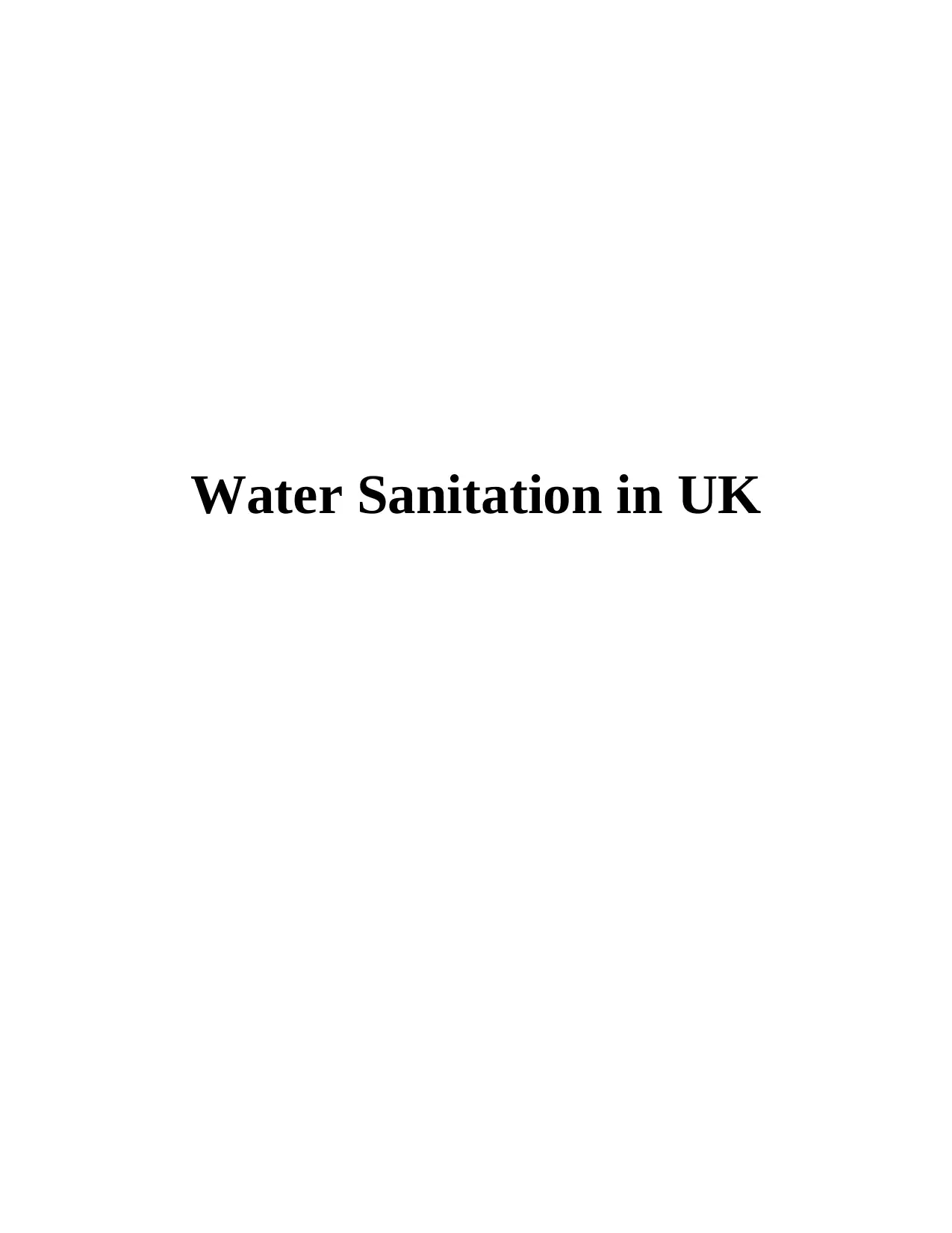
Water Sanitation in UK
Paraphrase This Document
Need a fresh take? Get an instant paraphrase of this document with our AI Paraphraser

TABLE OF CONTENTS
Introduction......................................................................................................................................1
Review Objective.............................................................................................................................2
Methods............................................................................................................................................2
Article Identification...................................................................................................................2
Eligibility of articles and article selection ..................................................................................4
Inclusion Criteria.........................................................................................................................4
Exclusion criteria .......................................................................................................................5
Protocol for Abstract / Title Screening ......................................................................................6
Protocol for Full Text Review....................................................................................................6
Quality Analysis (200)................................................................................................................7
Data extraction ...........................................................................................................................8
references.........................................................................................................................................9
Introduction......................................................................................................................................1
Review Objective.............................................................................................................................2
Methods............................................................................................................................................2
Article Identification...................................................................................................................2
Eligibility of articles and article selection ..................................................................................4
Inclusion Criteria.........................................................................................................................4
Exclusion criteria .......................................................................................................................5
Protocol for Abstract / Title Screening ......................................................................................6
Protocol for Full Text Review....................................................................................................6
Quality Analysis (200)................................................................................................................7
Data extraction ...........................................................................................................................8
references.........................................................................................................................................9
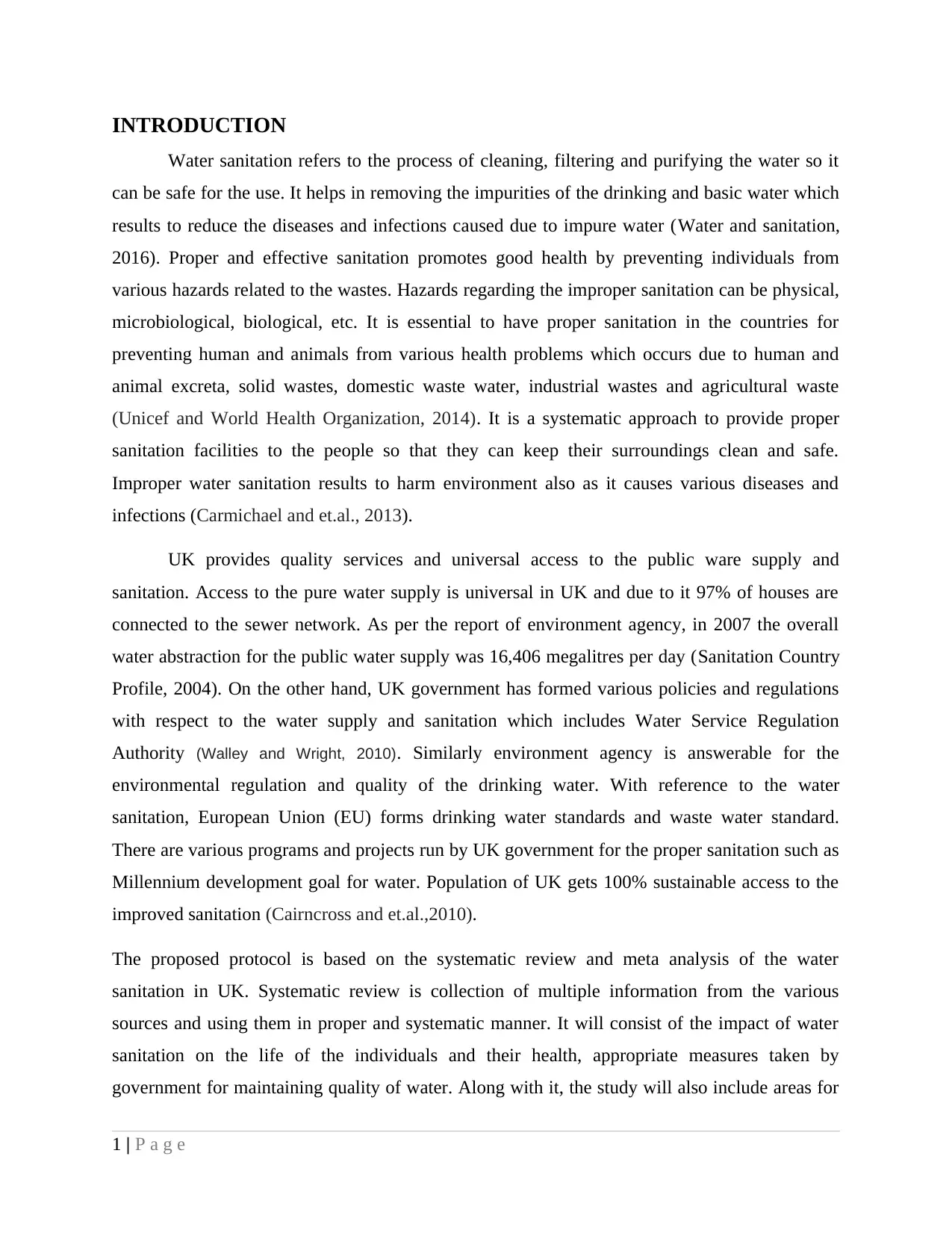
INTRODUCTION
Water sanitation refers to the process of cleaning, filtering and purifying the water so it
can be safe for the use. It helps in removing the impurities of the drinking and basic water which
results to reduce the diseases and infections caused due to impure water (Water and sanitation,
2016). Proper and effective sanitation promotes good health by preventing individuals from
various hazards related to the wastes. Hazards regarding the improper sanitation can be physical,
microbiological, biological, etc. It is essential to have proper sanitation in the countries for
preventing human and animals from various health problems which occurs due to human and
animal excreta, solid wastes, domestic waste water, industrial wastes and agricultural waste
(Unicef and World Health Organization, 2014). It is a systematic approach to provide proper
sanitation facilities to the people so that they can keep their surroundings clean and safe.
Improper water sanitation results to harm environment also as it causes various diseases and
infections (Carmichael and et.al., 2013).
UK provides quality services and universal access to the public ware supply and
sanitation. Access to the pure water supply is universal in UK and due to it 97% of houses are
connected to the sewer network. As per the report of environment agency, in 2007 the overall
water abstraction for the public water supply was 16,406 megalitres per day (Sanitation Country
Profile, 2004). On the other hand, UK government has formed various policies and regulations
with respect to the water supply and sanitation which includes Water Service Regulation
Authority (Walley and Wright, 2010). Similarly environment agency is answerable for the
environmental regulation and quality of the drinking water. With reference to the water
sanitation, European Union (EU) forms drinking water standards and waste water standard.
There are various programs and projects run by UK government for the proper sanitation such as
Millennium development goal for water. Population of UK gets 100% sustainable access to the
improved sanitation (Cairncross and et.al.,2010).
The proposed protocol is based on the systematic review and meta analysis of the water
sanitation in UK. Systematic review is collection of multiple information from the various
sources and using them in proper and systematic manner. It will consist of the impact of water
sanitation on the life of the individuals and their health, appropriate measures taken by
government for maintaining quality of water. Along with it, the study will also include areas for
1 | P a g e
Water sanitation refers to the process of cleaning, filtering and purifying the water so it
can be safe for the use. It helps in removing the impurities of the drinking and basic water which
results to reduce the diseases and infections caused due to impure water (Water and sanitation,
2016). Proper and effective sanitation promotes good health by preventing individuals from
various hazards related to the wastes. Hazards regarding the improper sanitation can be physical,
microbiological, biological, etc. It is essential to have proper sanitation in the countries for
preventing human and animals from various health problems which occurs due to human and
animal excreta, solid wastes, domestic waste water, industrial wastes and agricultural waste
(Unicef and World Health Organization, 2014). It is a systematic approach to provide proper
sanitation facilities to the people so that they can keep their surroundings clean and safe.
Improper water sanitation results to harm environment also as it causes various diseases and
infections (Carmichael and et.al., 2013).
UK provides quality services and universal access to the public ware supply and
sanitation. Access to the pure water supply is universal in UK and due to it 97% of houses are
connected to the sewer network. As per the report of environment agency, in 2007 the overall
water abstraction for the public water supply was 16,406 megalitres per day (Sanitation Country
Profile, 2004). On the other hand, UK government has formed various policies and regulations
with respect to the water supply and sanitation which includes Water Service Regulation
Authority (Walley and Wright, 2010). Similarly environment agency is answerable for the
environmental regulation and quality of the drinking water. With reference to the water
sanitation, European Union (EU) forms drinking water standards and waste water standard.
There are various programs and projects run by UK government for the proper sanitation such as
Millennium development goal for water. Population of UK gets 100% sustainable access to the
improved sanitation (Cairncross and et.al.,2010).
The proposed protocol is based on the systematic review and meta analysis of the water
sanitation in UK. Systematic review is collection of multiple information from the various
sources and using them in proper and systematic manner. It will consist of the impact of water
sanitation on the life of the individuals and their health, appropriate measures taken by
government for maintaining quality of water. Along with it, the study will also include areas for
1 | P a g e
⊘ This is a preview!⊘
Do you want full access?
Subscribe today to unlock all pages.

Trusted by 1+ million students worldwide
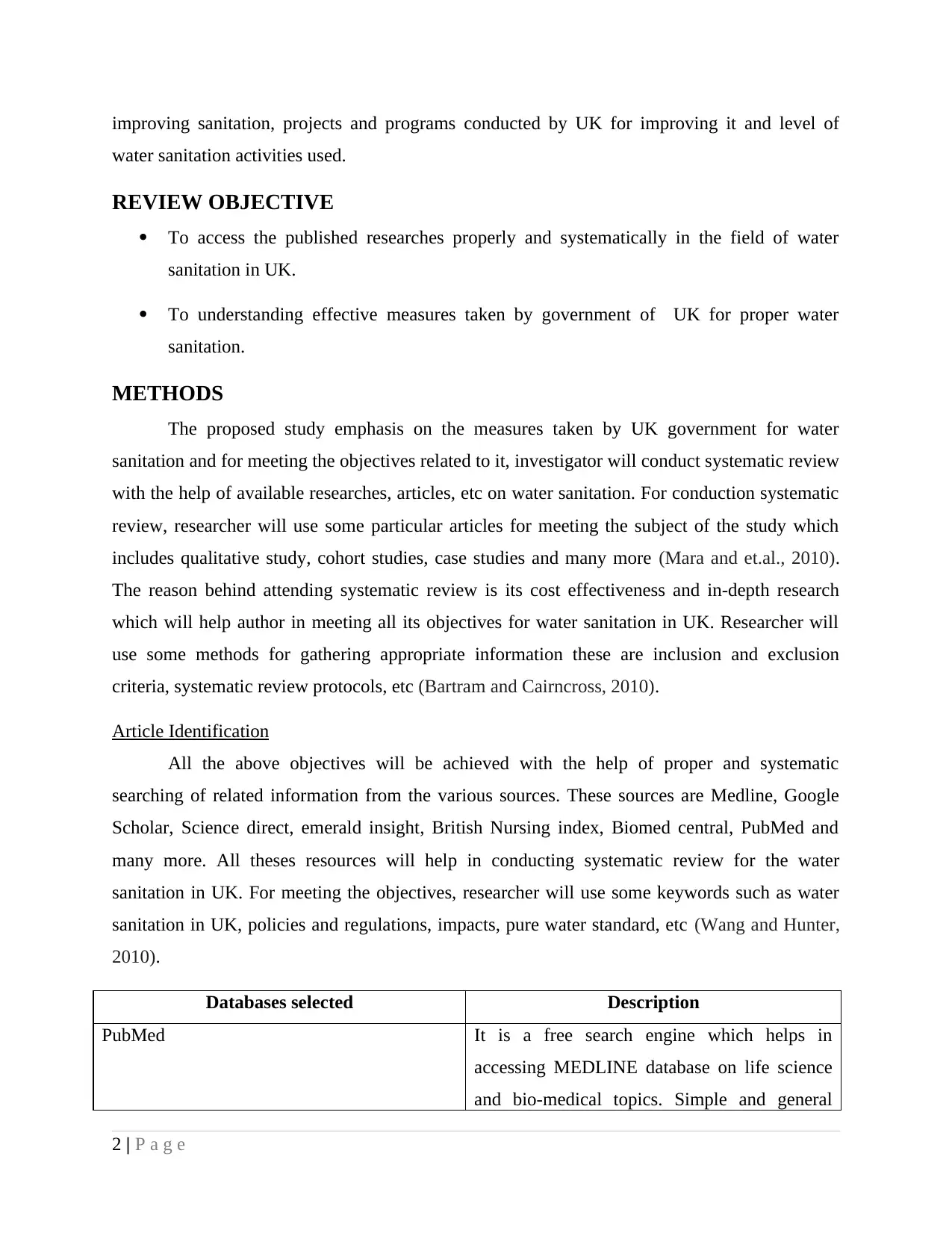
improving sanitation, projects and programs conducted by UK for improving it and level of
water sanitation activities used.
REVIEW OBJECTIVE
To access the published researches properly and systematically in the field of water
sanitation in UK.
To understanding effective measures taken by government of UK for proper water
sanitation.
METHODS
The proposed study emphasis on the measures taken by UK government for water
sanitation and for meeting the objectives related to it, investigator will conduct systematic review
with the help of available researches, articles, etc on water sanitation. For conduction systematic
review, researcher will use some particular articles for meeting the subject of the study which
includes qualitative study, cohort studies, case studies and many more (Mara and et.al., 2010).
The reason behind attending systematic review is its cost effectiveness and in-depth research
which will help author in meeting all its objectives for water sanitation in UK. Researcher will
use some methods for gathering appropriate information these are inclusion and exclusion
criteria, systematic review protocols, etc (Bartram and Cairncross, 2010).
Article Identification
All the above objectives will be achieved with the help of proper and systematic
searching of related information from the various sources. These sources are Medline, Google
Scholar, Science direct, emerald insight, British Nursing index, Biomed central, PubMed and
many more. All theses resources will help in conducting systematic review for the water
sanitation in UK. For meeting the objectives, researcher will use some keywords such as water
sanitation in UK, policies and regulations, impacts, pure water standard, etc (Wang and Hunter,
2010).
Databases selected Description
PubMed It is a free search engine which helps in
accessing MEDLINE database on life science
and bio-medical topics. Simple and general
2 | P a g e
water sanitation activities used.
REVIEW OBJECTIVE
To access the published researches properly and systematically in the field of water
sanitation in UK.
To understanding effective measures taken by government of UK for proper water
sanitation.
METHODS
The proposed study emphasis on the measures taken by UK government for water
sanitation and for meeting the objectives related to it, investigator will conduct systematic review
with the help of available researches, articles, etc on water sanitation. For conduction systematic
review, researcher will use some particular articles for meeting the subject of the study which
includes qualitative study, cohort studies, case studies and many more (Mara and et.al., 2010).
The reason behind attending systematic review is its cost effectiveness and in-depth research
which will help author in meeting all its objectives for water sanitation in UK. Researcher will
use some methods for gathering appropriate information these are inclusion and exclusion
criteria, systematic review protocols, etc (Bartram and Cairncross, 2010).
Article Identification
All the above objectives will be achieved with the help of proper and systematic
searching of related information from the various sources. These sources are Medline, Google
Scholar, Science direct, emerald insight, British Nursing index, Biomed central, PubMed and
many more. All theses resources will help in conducting systematic review for the water
sanitation in UK. For meeting the objectives, researcher will use some keywords such as water
sanitation in UK, policies and regulations, impacts, pure water standard, etc (Wang and Hunter,
2010).
Databases selected Description
PubMed It is a free search engine which helps in
accessing MEDLINE database on life science
and bio-medical topics. Simple and general
2 | P a g e
Paraphrase This Document
Need a fresh take? Get an instant paraphrase of this document with our AI Paraphraser

searches are taken place by entering key words
of the topic in the PubMed's search window.
Cochrane library It is a database which stores journal articles in
the area of medicine and other health-care
specialties which are provided by the Cochrane
Collaboration and other companies. It is
collection of systematic reviews and meta
analysis in the medical field (Wolf and et.al.,
2014).
Science Direct It is a online website which provides access to a
wide database of scientific and medical
research with the help of subscription. There
are four types of journals in this website which
are physical science and engineering, life
sciences, health sciences and social science and
humanities.
British Nursing Index This is a medical journal which covers various
areas of nursing. Along with the scholarly
information on the area of nursing and hospitals
this index also includes information about the
people, events, etc (Anand, 2013).
BioMed Central It is a UK based and for-profit scientific
publisher which is open access journal
publication. It hosts biomedical databases,
biology image library, cases databases, etc.
Emerald insight It is a scholarly publisher in the area of
academic journals and books. In this collection
of information is on management, business
education, library studies, health-care and
engineering. It consists of peer-reviewed,
international research in both established and
3 | P a g e
of the topic in the PubMed's search window.
Cochrane library It is a database which stores journal articles in
the area of medicine and other health-care
specialties which are provided by the Cochrane
Collaboration and other companies. It is
collection of systematic reviews and meta
analysis in the medical field (Wolf and et.al.,
2014).
Science Direct It is a online website which provides access to a
wide database of scientific and medical
research with the help of subscription. There
are four types of journals in this website which
are physical science and engineering, life
sciences, health sciences and social science and
humanities.
British Nursing Index This is a medical journal which covers various
areas of nursing. Along with the scholarly
information on the area of nursing and hospitals
this index also includes information about the
people, events, etc (Anand, 2013).
BioMed Central It is a UK based and for-profit scientific
publisher which is open access journal
publication. It hosts biomedical databases,
biology image library, cases databases, etc.
Emerald insight It is a scholarly publisher in the area of
academic journals and books. In this collection
of information is on management, business
education, library studies, health-care and
engineering. It consists of peer-reviewed,
international research in both established and
3 | P a g e

emerging areas (Harvey, 2010).
CINAHL (Cumulative Index to Nursing and
Allied Health Literature)
Basically, it is an index of English or any other
language journal articles in the field of
nursing, bio-medicine, health-care and allied
health.
Google scholar It is a search engine which is free to access and
contains full text or meta data of academic
literature. Its index consists of peer- reviewed
online journals of UK and UK, academic books
and other non-peer reviewed journals.
Eligibility of articles and article selection
Articles with respect to the research will be selected independently by the 2 reviewers. At the
first stage, titles and abstract of the study will be scanned by reviewers by following inclusion
criteria and then selected articles will be read by them for collecting relevant information as per
the topic (Baguma, Loiskandl and Jung, 2010). In addition to it, the work related to the chosen
articles will be reviewed for meeting inclusion criteria. Other researcher will also be contacted
by the reviewers as per the necessity. Those studies which are not relevant to the measures taken
by the UK government in the field of water sanitation are excluded by the authors (Akl and et.al.,
2010).
Inclusion Criteria
It refers to those characteristics which are relevant to the topic of the research and can be
included in it for achieving its objectives. Inclusion criteria includes those attributes which are
important for the study. Design: For the present study, case control, qualitative studies and systematic review will
be used by the investigator for meeting the objectives of the present investigation i.e.
water sanitation in the UK. Only those articles and literature which are appropriate for the
research will be selected by the author. These designs will help researcher in getting
information and data on the water sanitation of UK (Fritsh, 2016). Case control will help
in getting cases related to the water sanitation problems, impacts, measures, etc.
Information which is irrelevant to the subject will be excluded by the author. Systematic
4 | P a g e
CINAHL (Cumulative Index to Nursing and
Allied Health Literature)
Basically, it is an index of English or any other
language journal articles in the field of
nursing, bio-medicine, health-care and allied
health.
Google scholar It is a search engine which is free to access and
contains full text or meta data of academic
literature. Its index consists of peer- reviewed
online journals of UK and UK, academic books
and other non-peer reviewed journals.
Eligibility of articles and article selection
Articles with respect to the research will be selected independently by the 2 reviewers. At the
first stage, titles and abstract of the study will be scanned by reviewers by following inclusion
criteria and then selected articles will be read by them for collecting relevant information as per
the topic (Baguma, Loiskandl and Jung, 2010). In addition to it, the work related to the chosen
articles will be reviewed for meeting inclusion criteria. Other researcher will also be contacted
by the reviewers as per the necessity. Those studies which are not relevant to the measures taken
by the UK government in the field of water sanitation are excluded by the authors (Akl and et.al.,
2010).
Inclusion Criteria
It refers to those characteristics which are relevant to the topic of the research and can be
included in it for achieving its objectives. Inclusion criteria includes those attributes which are
important for the study. Design: For the present study, case control, qualitative studies and systematic review will
be used by the investigator for meeting the objectives of the present investigation i.e.
water sanitation in the UK. Only those articles and literature which are appropriate for the
research will be selected by the author. These designs will help researcher in getting
information and data on the water sanitation of UK (Fritsh, 2016). Case control will help
in getting cases related to the water sanitation problems, impacts, measures, etc.
Information which is irrelevant to the subject will be excluded by the author. Systematic
4 | P a g e
⊘ This is a preview!⊘
Do you want full access?
Subscribe today to unlock all pages.

Trusted by 1+ million students worldwide
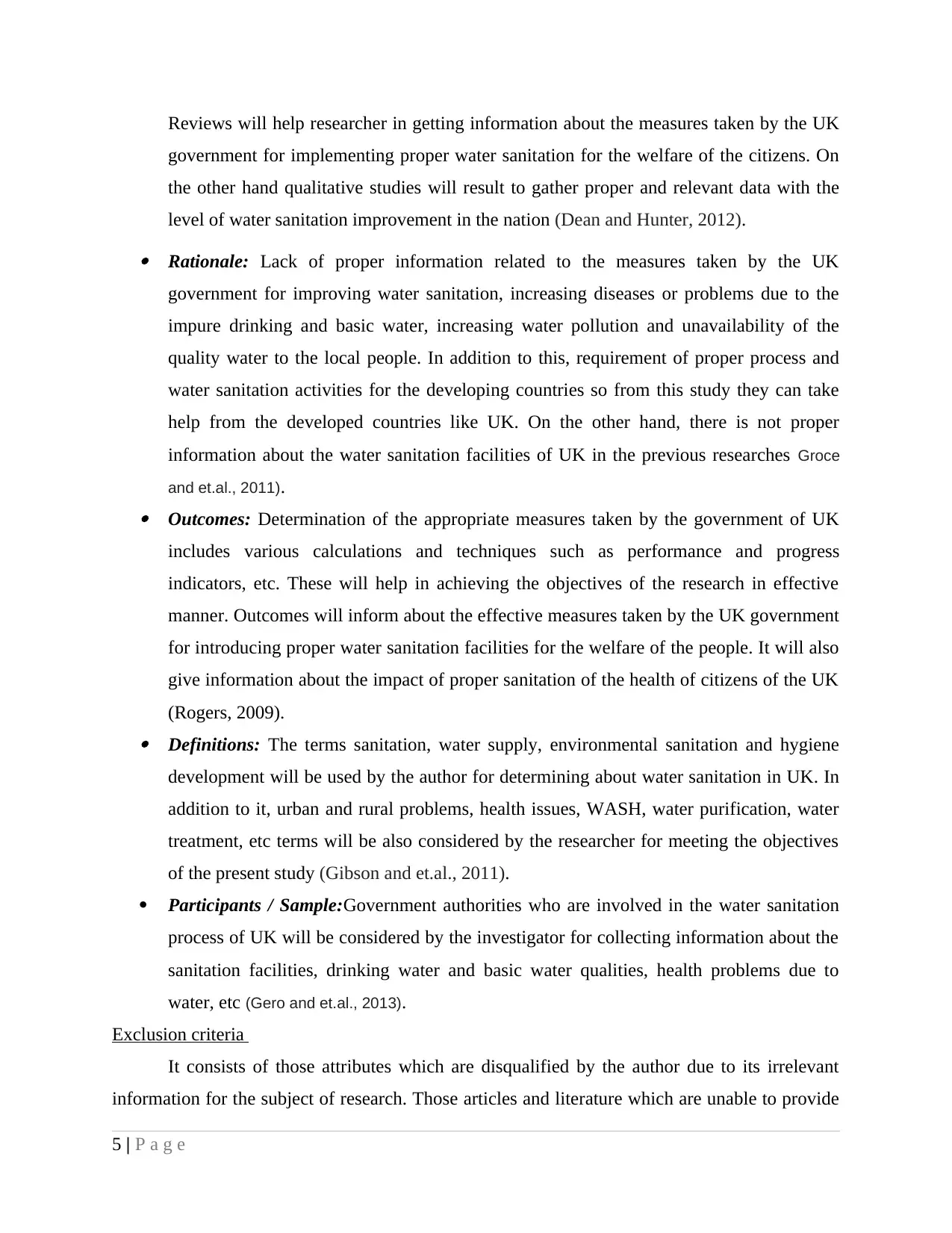
Reviews will help researcher in getting information about the measures taken by the UK
government for implementing proper water sanitation for the welfare of the citizens. On
the other hand qualitative studies will result to gather proper and relevant data with the
level of water sanitation improvement in the nation (Dean and Hunter, 2012). Rationale: Lack of proper information related to the measures taken by the UK
government for improving water sanitation, increasing diseases or problems due to the
impure drinking and basic water, increasing water pollution and unavailability of the
quality water to the local people. In addition to this, requirement of proper process and
water sanitation activities for the developing countries so from this study they can take
help from the developed countries like UK. On the other hand, there is not proper
information about the water sanitation facilities of UK in the previous researches Groce
and et.al., 2011). Outcomes: Determination of the appropriate measures taken by the government of UK
includes various calculations and techniques such as performance and progress
indicators, etc. These will help in achieving the objectives of the research in effective
manner. Outcomes will inform about the effective measures taken by the UK government
for introducing proper water sanitation facilities for the welfare of the people. It will also
give information about the impact of proper sanitation of the health of citizens of the UK
(Rogers, 2009). Definitions: The terms sanitation, water supply, environmental sanitation and hygiene
development will be used by the author for determining about water sanitation in UK. In
addition to it, urban and rural problems, health issues, WASH, water purification, water
treatment, etc terms will be also considered by the researcher for meeting the objectives
of the present study (Gibson and et.al., 2011).
Participants / Sample:Government authorities who are involved in the water sanitation
process of UK will be considered by the investigator for collecting information about the
sanitation facilities, drinking water and basic water qualities, health problems due to
water, etc (Gero and et.al., 2013).
Exclusion criteria
It consists of those attributes which are disqualified by the author due to its irrelevant
information for the subject of research. Those articles and literature which are unable to provide
5 | P a g e
government for implementing proper water sanitation for the welfare of the citizens. On
the other hand qualitative studies will result to gather proper and relevant data with the
level of water sanitation improvement in the nation (Dean and Hunter, 2012). Rationale: Lack of proper information related to the measures taken by the UK
government for improving water sanitation, increasing diseases or problems due to the
impure drinking and basic water, increasing water pollution and unavailability of the
quality water to the local people. In addition to this, requirement of proper process and
water sanitation activities for the developing countries so from this study they can take
help from the developed countries like UK. On the other hand, there is not proper
information about the water sanitation facilities of UK in the previous researches Groce
and et.al., 2011). Outcomes: Determination of the appropriate measures taken by the government of UK
includes various calculations and techniques such as performance and progress
indicators, etc. These will help in achieving the objectives of the research in effective
manner. Outcomes will inform about the effective measures taken by the UK government
for introducing proper water sanitation facilities for the welfare of the people. It will also
give information about the impact of proper sanitation of the health of citizens of the UK
(Rogers, 2009). Definitions: The terms sanitation, water supply, environmental sanitation and hygiene
development will be used by the author for determining about water sanitation in UK. In
addition to it, urban and rural problems, health issues, WASH, water purification, water
treatment, etc terms will be also considered by the researcher for meeting the objectives
of the present study (Gibson and et.al., 2011).
Participants / Sample:Government authorities who are involved in the water sanitation
process of UK will be considered by the investigator for collecting information about the
sanitation facilities, drinking water and basic water qualities, health problems due to
water, etc (Gero and et.al., 2013).
Exclusion criteria
It consists of those attributes which are disqualified by the author due to its irrelevant
information for the subject of research. Those articles and literature which are unable to provide
5 | P a g e
Paraphrase This Document
Need a fresh take? Get an instant paraphrase of this document with our AI Paraphraser

proper information about the water sanitation in UK or those information which are harmful for
intervention will be excluded by the researcher. In addition to this, investigator will disqualify
wrong studies, researches which are in other language instead of English, articles which are not
able to give proper outcome, literature which are not in context with water sanitation in UK
(Freeman and et.al. 2014). Along with this, investigator will disqualify those journals or articles
which are published before 2010. By excluding all the above factors, author will able to collect
appropriate and effective information about the water sanitation in UK (Harvey, 2010).
Protocol for Abstract / Title Screening
On the basis of the inclusion criteria there are some questions formed by the investigator
for abstract/title screening process. These questions will help the author in determining whether
the article is appropriate for achieving the objective of the present study or not. If the answer of
these questions are in yes then articles or literature will be selected or included by the researcher
for the full text review otherwise not (Dean and Hunter, 2012). The developed questions are as
follows.
Does the literature takes place in UK?
Is the design of the study according to the decided inclusion criteria?
Are government authorities included in the study?
Does article have relevant information about the measures taken by the UK government
for proper water sanitation?
Has the article being published in a peer-reviewed journal between 2010 to present?
Are the government authorities involved in water sanitation projects or programs
conducted by the UK government?
Protocol for Full Text Review
On the basis of inclusion criteria decided by the author, there are series of questions in
yes or no for the full text review. Some questions are developed by the researcher for selecting
articles for the present and future study as well (Fogelberg, 2010). If the answers of question 1
and 2 are yes, then the articles will be chosen by the researcher for the data extraction for
measures taken by the UK government for water sanitation. If answer is no then in such case,
articles will be disqualified by the investigator (Mara and et.al., 2010). On the other hand, if
6 | P a g e
intervention will be excluded by the researcher. In addition to this, investigator will disqualify
wrong studies, researches which are in other language instead of English, articles which are not
able to give proper outcome, literature which are not in context with water sanitation in UK
(Freeman and et.al. 2014). Along with this, investigator will disqualify those journals or articles
which are published before 2010. By excluding all the above factors, author will able to collect
appropriate and effective information about the water sanitation in UK (Harvey, 2010).
Protocol for Abstract / Title Screening
On the basis of the inclusion criteria there are some questions formed by the investigator
for abstract/title screening process. These questions will help the author in determining whether
the article is appropriate for achieving the objective of the present study or not. If the answer of
these questions are in yes then articles or literature will be selected or included by the researcher
for the full text review otherwise not (Dean and Hunter, 2012). The developed questions are as
follows.
Does the literature takes place in UK?
Is the design of the study according to the decided inclusion criteria?
Are government authorities included in the study?
Does article have relevant information about the measures taken by the UK government
for proper water sanitation?
Has the article being published in a peer-reviewed journal between 2010 to present?
Are the government authorities involved in water sanitation projects or programs
conducted by the UK government?
Protocol for Full Text Review
On the basis of inclusion criteria decided by the author, there are series of questions in
yes or no for the full text review. Some questions are developed by the researcher for selecting
articles for the present and future study as well (Fogelberg, 2010). If the answers of question 1
and 2 are yes, then the articles will be chosen by the researcher for the data extraction for
measures taken by the UK government for water sanitation. If answer is no then in such case,
articles will be disqualified by the investigator (Mara and et.al., 2010). On the other hand, if
6 | P a g e
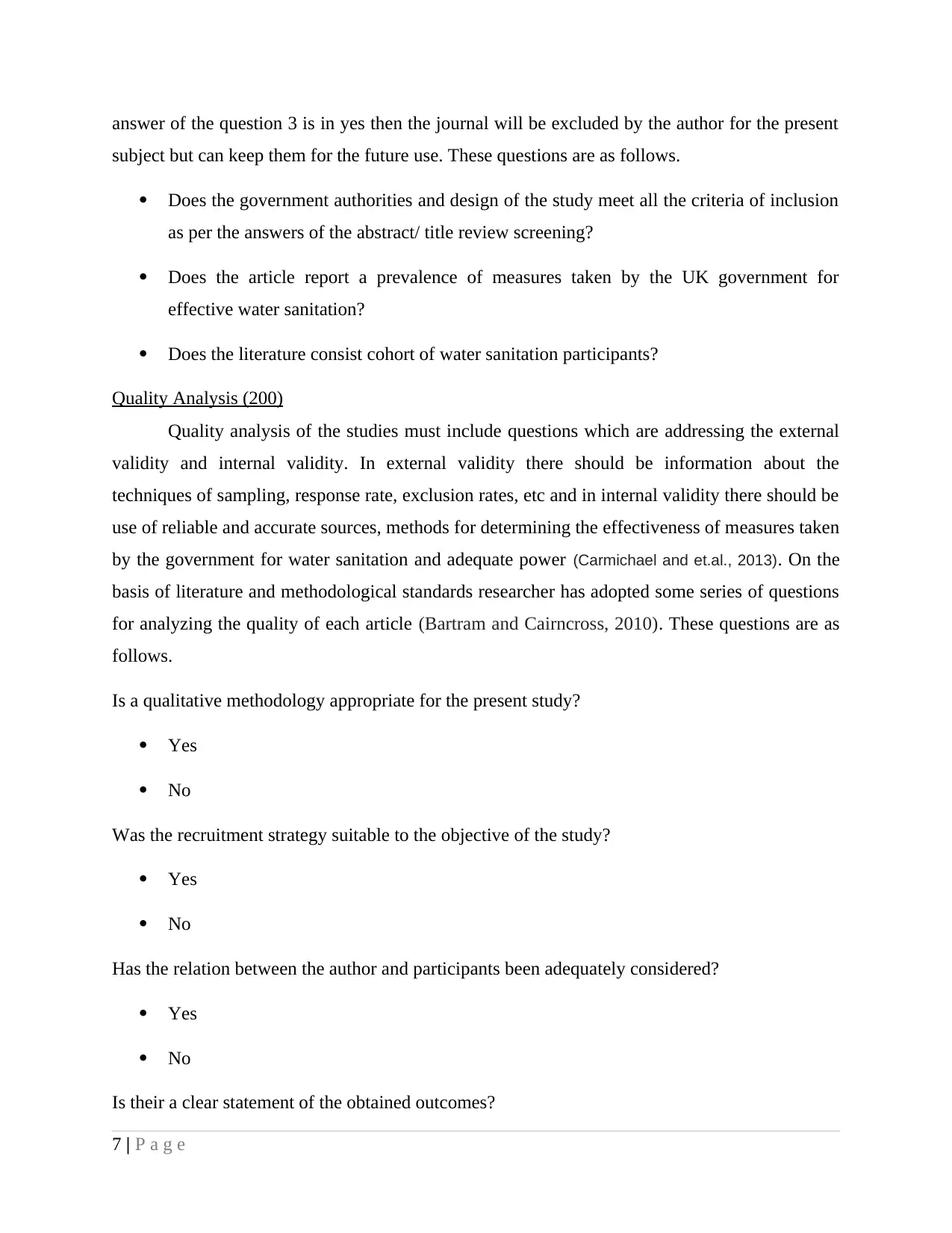
answer of the question 3 is in yes then the journal will be excluded by the author for the present
subject but can keep them for the future use. These questions are as follows.
Does the government authorities and design of the study meet all the criteria of inclusion
as per the answers of the abstract/ title review screening?
Does the article report a prevalence of measures taken by the UK government for
effective water sanitation?
Does the literature consist cohort of water sanitation participants?
Quality Analysis (200)
Quality analysis of the studies must include questions which are addressing the external
validity and internal validity. In external validity there should be information about the
techniques of sampling, response rate, exclusion rates, etc and in internal validity there should be
use of reliable and accurate sources, methods for determining the effectiveness of measures taken
by the government for water sanitation and adequate power (Carmichael and et.al., 2013). On the
basis of literature and methodological standards researcher has adopted some series of questions
for analyzing the quality of each article (Bartram and Cairncross, 2010). These questions are as
follows.
Is a qualitative methodology appropriate for the present study?
Yes
No
Was the recruitment strategy suitable to the objective of the study?
Yes
No
Has the relation between the author and participants been adequately considered?
Yes
No
Is their a clear statement of the obtained outcomes?
7 | P a g e
subject but can keep them for the future use. These questions are as follows.
Does the government authorities and design of the study meet all the criteria of inclusion
as per the answers of the abstract/ title review screening?
Does the article report a prevalence of measures taken by the UK government for
effective water sanitation?
Does the literature consist cohort of water sanitation participants?
Quality Analysis (200)
Quality analysis of the studies must include questions which are addressing the external
validity and internal validity. In external validity there should be information about the
techniques of sampling, response rate, exclusion rates, etc and in internal validity there should be
use of reliable and accurate sources, methods for determining the effectiveness of measures taken
by the government for water sanitation and adequate power (Carmichael and et.al., 2013). On the
basis of literature and methodological standards researcher has adopted some series of questions
for analyzing the quality of each article (Bartram and Cairncross, 2010). These questions are as
follows.
Is a qualitative methodology appropriate for the present study?
Yes
No
Was the recruitment strategy suitable to the objective of the study?
Yes
No
Has the relation between the author and participants been adequately considered?
Yes
No
Is their a clear statement of the obtained outcomes?
7 | P a g e
⊘ This is a preview!⊘
Do you want full access?
Subscribe today to unlock all pages.

Trusted by 1+ million students worldwide

Yes
Cannot tell
Did the researcher look for the appropriate type of papers?
Yes
No
Cannot tell
Can the outcomes be applied for the welfare of the local people?
Yes
Cannot tell
No
Data extraction
It is the process of retrieving relevant data from the available sources for further data
processing for achieving the objectives of the researches. With the help of this process, author
will able to extract proper and effective data for the effective measures taken by UK government
for appropriate water sanitation and this will help later in further processing of this study. For the
present study, after determining the articles as per the decided inclusion criteria, author will
independently review every article or literature for extracting important and meaningful data
from them as per the topic of current study (Cairncross and et.al.,2010). They will maintain the
standard of data by following study design, population, size, dates of the study, measures used by
the government for water sanitation in UK, impact of water sanitation programs or projects on
the local people, decrease in disease due to water impurity and other factors. This whole process
can take place more effectively by two authors as they will able to extract information in more
effective and appropriate manner. Any error in the process during the data extraction can be
resolved by joint review on the original articles (Wolf and et.al., 2014).
8 | P a g e
Cannot tell
Did the researcher look for the appropriate type of papers?
Yes
No
Cannot tell
Can the outcomes be applied for the welfare of the local people?
Yes
Cannot tell
No
Data extraction
It is the process of retrieving relevant data from the available sources for further data
processing for achieving the objectives of the researches. With the help of this process, author
will able to extract proper and effective data for the effective measures taken by UK government
for appropriate water sanitation and this will help later in further processing of this study. For the
present study, after determining the articles as per the decided inclusion criteria, author will
independently review every article or literature for extracting important and meaningful data
from them as per the topic of current study (Cairncross and et.al.,2010). They will maintain the
standard of data by following study design, population, size, dates of the study, measures used by
the government for water sanitation in UK, impact of water sanitation programs or projects on
the local people, decrease in disease due to water impurity and other factors. This whole process
can take place more effectively by two authors as they will able to extract information in more
effective and appropriate manner. Any error in the process during the data extraction can be
resolved by joint review on the original articles (Wolf and et.al., 2014).
8 | P a g e
Paraphrase This Document
Need a fresh take? Get an instant paraphrase of this document with our AI Paraphraser
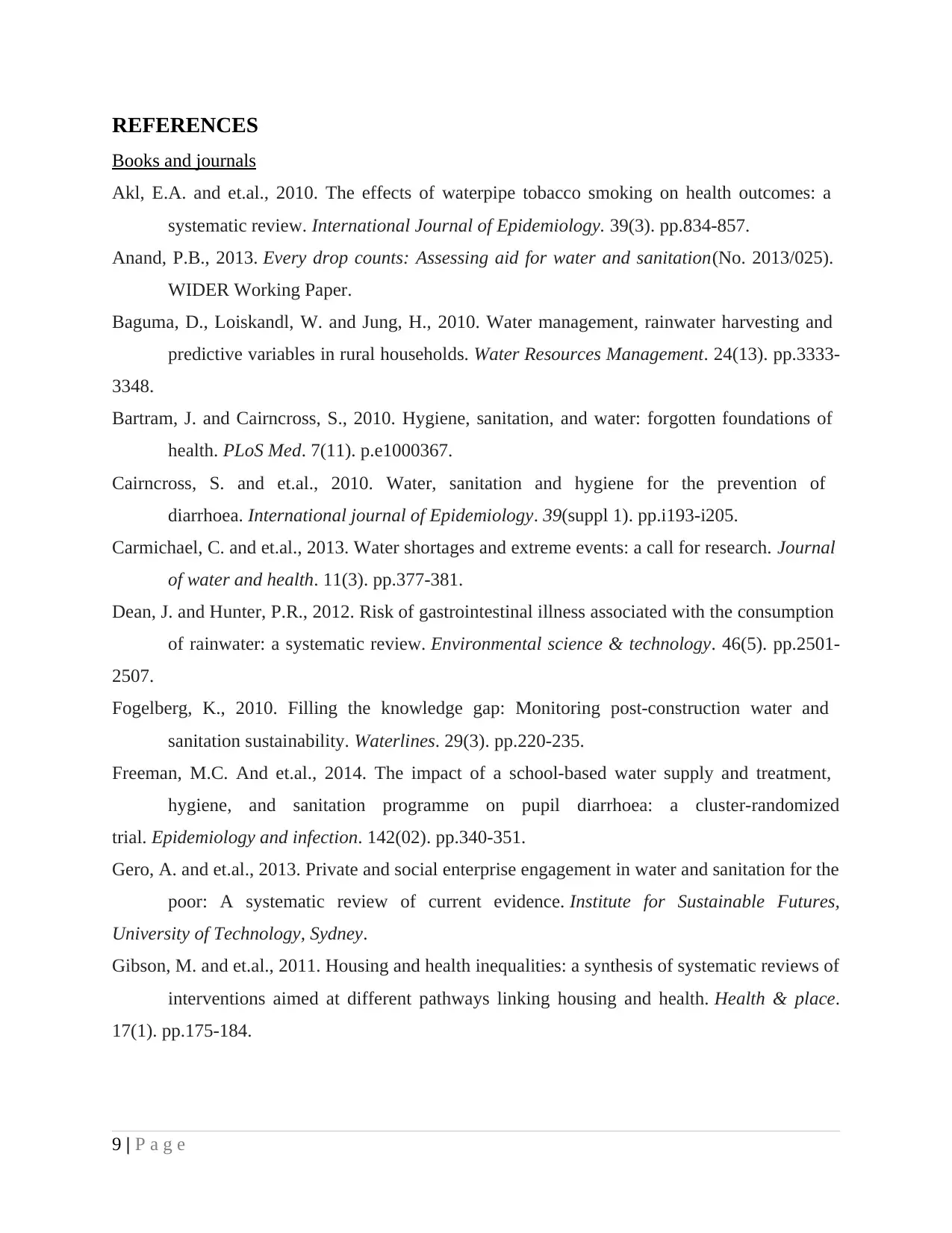
REFERENCES
Books and journals
Akl, E.A. and et.al., 2010. The effects of waterpipe tobacco smoking on health outcomes: a
systematic review. International Journal of Epidemiology. 39(3). pp.834-857.
Anand, P.B., 2013. Every drop counts: Assessing aid for water and sanitation(No. 2013/025).
WIDER Working Paper.
Baguma, D., Loiskandl, W. and Jung, H., 2010. Water management, rainwater harvesting and
predictive variables in rural households. Water Resources Management. 24(13). pp.3333-
3348.
Bartram, J. and Cairncross, S., 2010. Hygiene, sanitation, and water: forgotten foundations of
health. PLoS Med. 7(11). p.e1000367.
Cairncross, S. and et.al., 2010. Water, sanitation and hygiene for the prevention of
diarrhoea. International journal of Epidemiology. 39(suppl 1). pp.i193-i205.
Carmichael, C. and et.al., 2013. Water shortages and extreme events: a call for research. Journal
of water and health. 11(3). pp.377-381.
Dean, J. and Hunter, P.R., 2012. Risk of gastrointestinal illness associated with the consumption
of rainwater: a systematic review. Environmental science & technology. 46(5). pp.2501-
2507.
Fogelberg, K., 2010. Filling the knowledge gap: Monitoring post-construction water and
sanitation sustainability. Waterlines. 29(3). pp.220-235.
Freeman, M.C. And et.al., 2014. The impact of a school-based water supply and treatment,
hygiene, and sanitation programme on pupil diarrhoea: a cluster-randomized
trial. Epidemiology and infection. 142(02). pp.340-351.
Gero, A. and et.al., 2013. Private and social enterprise engagement in water and sanitation for the
poor: A systematic review of current evidence. Institute for Sustainable Futures,
University of Technology, Sydney.
Gibson, M. and et.al., 2011. Housing and health inequalities: a synthesis of systematic reviews of
interventions aimed at different pathways linking housing and health. Health & place.
17(1). pp.175-184.
9 | P a g e
Books and journals
Akl, E.A. and et.al., 2010. The effects of waterpipe tobacco smoking on health outcomes: a
systematic review. International Journal of Epidemiology. 39(3). pp.834-857.
Anand, P.B., 2013. Every drop counts: Assessing aid for water and sanitation(No. 2013/025).
WIDER Working Paper.
Baguma, D., Loiskandl, W. and Jung, H., 2010. Water management, rainwater harvesting and
predictive variables in rural households. Water Resources Management. 24(13). pp.3333-
3348.
Bartram, J. and Cairncross, S., 2010. Hygiene, sanitation, and water: forgotten foundations of
health. PLoS Med. 7(11). p.e1000367.
Cairncross, S. and et.al., 2010. Water, sanitation and hygiene for the prevention of
diarrhoea. International journal of Epidemiology. 39(suppl 1). pp.i193-i205.
Carmichael, C. and et.al., 2013. Water shortages and extreme events: a call for research. Journal
of water and health. 11(3). pp.377-381.
Dean, J. and Hunter, P.R., 2012. Risk of gastrointestinal illness associated with the consumption
of rainwater: a systematic review. Environmental science & technology. 46(5). pp.2501-
2507.
Fogelberg, K., 2010. Filling the knowledge gap: Monitoring post-construction water and
sanitation sustainability. Waterlines. 29(3). pp.220-235.
Freeman, M.C. And et.al., 2014. The impact of a school-based water supply and treatment,
hygiene, and sanitation programme on pupil diarrhoea: a cluster-randomized
trial. Epidemiology and infection. 142(02). pp.340-351.
Gero, A. and et.al., 2013. Private and social enterprise engagement in water and sanitation for the
poor: A systematic review of current evidence. Institute for Sustainable Futures,
University of Technology, Sydney.
Gibson, M. and et.al., 2011. Housing and health inequalities: a synthesis of systematic reviews of
interventions aimed at different pathways linking housing and health. Health & place.
17(1). pp.175-184.
9 | P a g e
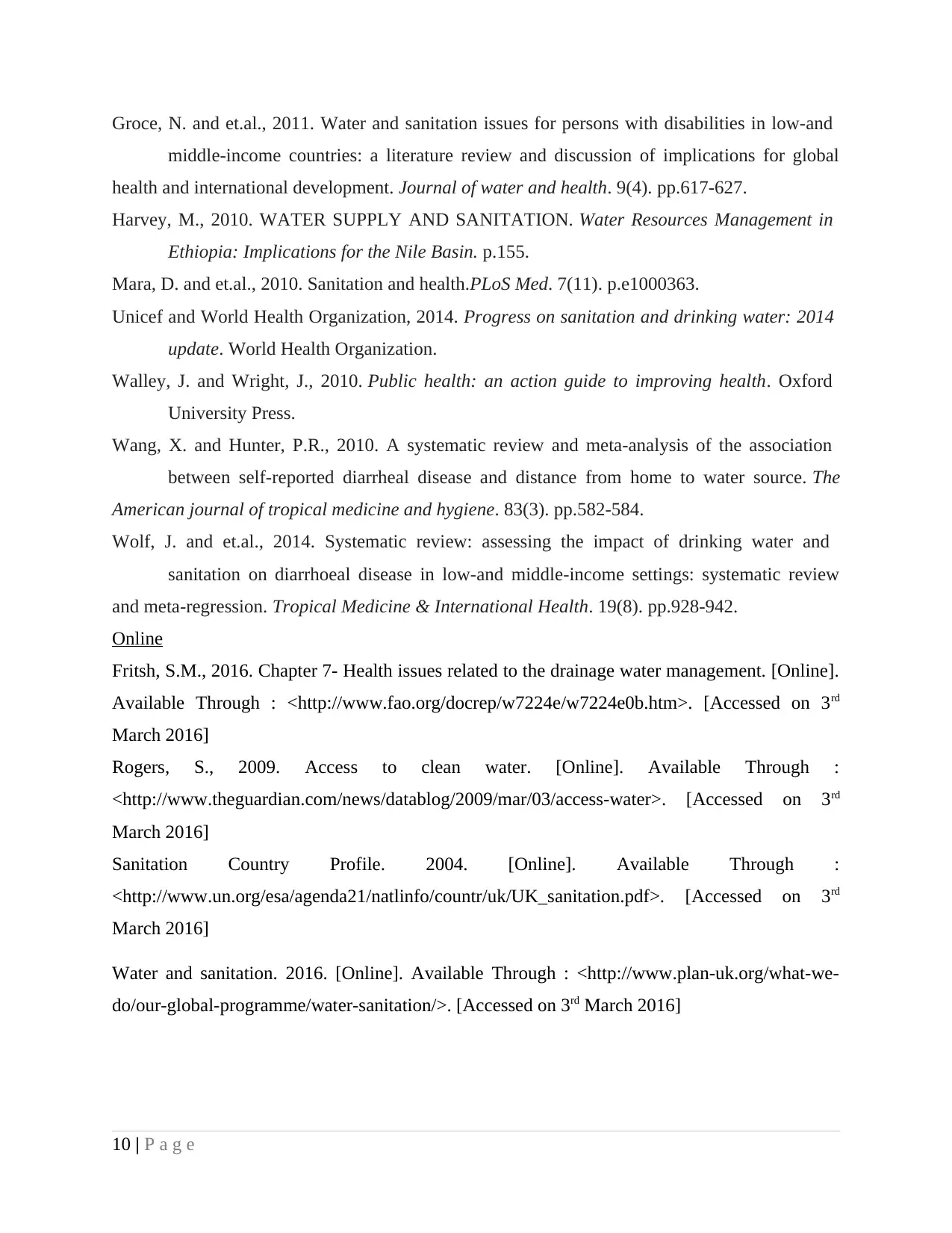
Groce, N. and et.al., 2011. Water and sanitation issues for persons with disabilities in low-and
middle-income countries: a literature review and discussion of implications for global
health and international development. Journal of water and health. 9(4). pp.617-627.
Harvey, M., 2010. WATER SUPPLY AND SANITATION. Water Resources Management in
Ethiopia: Implications for the Nile Basin. p.155.
Mara, D. and et.al., 2010. Sanitation and health.PLoS Med. 7(11). p.e1000363.
Unicef and World Health Organization, 2014. Progress on sanitation and drinking water: 2014
update. World Health Organization.
Walley, J. and Wright, J., 2010. Public health: an action guide to improving health. Oxford
University Press.
Wang, X. and Hunter, P.R., 2010. A systematic review and meta-analysis of the association
between self-reported diarrheal disease and distance from home to water source. The
American journal of tropical medicine and hygiene. 83(3). pp.582-584.
Wolf, J. and et.al., 2014. Systematic review: assessing the impact of drinking water and
sanitation on diarrhoeal disease in low‐and middle‐income settings: systematic review
and meta‐regression. Tropical Medicine & International Health. 19(8). pp.928-942.
Online
Fritsh, S.M., 2016. Chapter 7- Health issues related to the drainage water management. [Online].
Available Through : <http://www.fao.org/docrep/w7224e/w7224e0b.htm>. [Accessed on 3rd
March 2016]
Rogers, S., 2009. Access to clean water. [Online]. Available Through :
<http://www.theguardian.com/news/datablog/2009/mar/03/access-water>. [Accessed on 3rd
March 2016]
Sanitation Country Profile. 2004. [Online]. Available Through :
<http://www.un.org/esa/agenda21/natlinfo/countr/uk/UK_sanitation.pdf>. [Accessed on 3rd
March 2016]
Water and sanitation. 2016. [Online]. Available Through : <http://www.plan-uk.org/what-we-
do/our-global-programme/water-sanitation/>. [Accessed on 3rd March 2016]
10 | P a g e
middle-income countries: a literature review and discussion of implications for global
health and international development. Journal of water and health. 9(4). pp.617-627.
Harvey, M., 2010. WATER SUPPLY AND SANITATION. Water Resources Management in
Ethiopia: Implications for the Nile Basin. p.155.
Mara, D. and et.al., 2010. Sanitation and health.PLoS Med. 7(11). p.e1000363.
Unicef and World Health Organization, 2014. Progress on sanitation and drinking water: 2014
update. World Health Organization.
Walley, J. and Wright, J., 2010. Public health: an action guide to improving health. Oxford
University Press.
Wang, X. and Hunter, P.R., 2010. A systematic review and meta-analysis of the association
between self-reported diarrheal disease and distance from home to water source. The
American journal of tropical medicine and hygiene. 83(3). pp.582-584.
Wolf, J. and et.al., 2014. Systematic review: assessing the impact of drinking water and
sanitation on diarrhoeal disease in low‐and middle‐income settings: systematic review
and meta‐regression. Tropical Medicine & International Health. 19(8). pp.928-942.
Online
Fritsh, S.M., 2016. Chapter 7- Health issues related to the drainage water management. [Online].
Available Through : <http://www.fao.org/docrep/w7224e/w7224e0b.htm>. [Accessed on 3rd
March 2016]
Rogers, S., 2009. Access to clean water. [Online]. Available Through :
<http://www.theguardian.com/news/datablog/2009/mar/03/access-water>. [Accessed on 3rd
March 2016]
Sanitation Country Profile. 2004. [Online]. Available Through :
<http://www.un.org/esa/agenda21/natlinfo/countr/uk/UK_sanitation.pdf>. [Accessed on 3rd
March 2016]
Water and sanitation. 2016. [Online]. Available Through : <http://www.plan-uk.org/what-we-
do/our-global-programme/water-sanitation/>. [Accessed on 3rd March 2016]
10 | P a g e
⊘ This is a preview!⊘
Do you want full access?
Subscribe today to unlock all pages.

Trusted by 1+ million students worldwide

11 | P a g e
1 out of 13
Related Documents
Your All-in-One AI-Powered Toolkit for Academic Success.
+13062052269
info@desklib.com
Available 24*7 on WhatsApp / Email
![[object Object]](/_next/static/media/star-bottom.7253800d.svg)
Unlock your academic potential
© 2024 | Zucol Services PVT LTD | All rights reserved.





